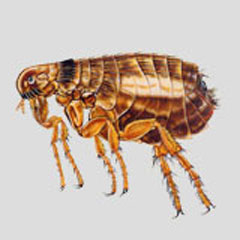Are Fleas More of a Problem Than Before?
By Chris Williams on April 13, 2013.
 For many of you, fleas maybe never went away. But those of us in the pest control business remember years ago when fleas were a serious pest problem and a big part of our business. Then along came all of the “on-animal” flea products that customers could get from their veterinarian. The emphasis shifted from treating the premises to treating the pet. Pet owners were able to treat their pets themselves with oral or pour-on products that killed fleas much better than flea collars and other over-the-counter products.
For many of you, fleas maybe never went away. But those of us in the pest control business remember years ago when fleas were a serious pest problem and a big part of our business. Then along came all of the “on-animal” flea products that customers could get from their veterinarian. The emphasis shifted from treating the premises to treating the pet. Pet owners were able to treat their pets themselves with oral or pour-on products that killed fleas much better than flea collars and other over-the-counter products.
Lately though, fleas seem to be making a comeback as more customers are requesting flea service. Some say that the topical, on-animal products don’t seem to work like they used to. Speculation is that fleas may be developing resistance to the insecticides in the products.
It’s time to remind people of flea basics. Don’t stop treating your pet. That’s a very important part of the control process. But there are other steps you can take around your home that will help reduce the number of fleas that your pet has to deal with.
Flea Biology 101
Adult fleas live on your pet; they almost never leave your pet’s body. When the female flea lays her eggs (up to 20 per day), they drop off of your pet, usually ending up in pet resting areas and along pet travel routes. A few days later the eggs hatch into wiggly, wormlike flea larvae. The larvae feed on dried blood (in the form of adult flea feces), skin flakes, and other organic debris for a week or more. Then they pupate (still in pet resting areas or deep in carpeting) and emerge later as adult fleas, looking for your pet. If your pet has been treated, then the fleas should be killed as they move around on the animal or after they feed on its blood.
Vacuum
Vacuuming is not a cure-all for flea problems. In fact, vacuuming does not even remove the flea larvae deep in the carpet pile. Vacuuming does remove some flea eggs and it removes adult flea feces and other debris that the larvae feed on. Concentrate on areas where your pest rests and areas under furniture that your pet lays on. Vacuum before you have a professional flea treatment to fluff up carpet nap so insecticides can penetrate, and so you won’t feel the need to vacuum soon after the treatment.
Wash pet bedding
Wash your pet’s bedding, or the pillow, or whatever your pet lays on, once a week. This is where you will find the greatest number of flea eggs and larvae. Use hot water and dry the bedding on high heat to kill eggs and larvae. If your pet lays directly on the couch, or a chair, or your bed, consider laying a rug or towel or something on top that can be laundered.
Get professional help
It’s very hard to get rid of a flea problem without treatment of your home, and sometimes also your yard. Bottom line is that treatment of your pet will kill the adult fleas on the animal, but will not affect developing eggs and larvae elsewhere in your home. Treatment of your home will kill flea eggs and larvae, but will not affect adult fleas on your pet. You need dual action flea control.
Call a pest control professional for treatment of areas in your home that are likely to have developing flea larvae. If your pet goes outside, there may be flea “hot spots” in your yard that are reinfesting your pet after your home has been treated. Those need to be treated as well. As the weather warms up, we expect flea calls to increase as fleas become active outside.